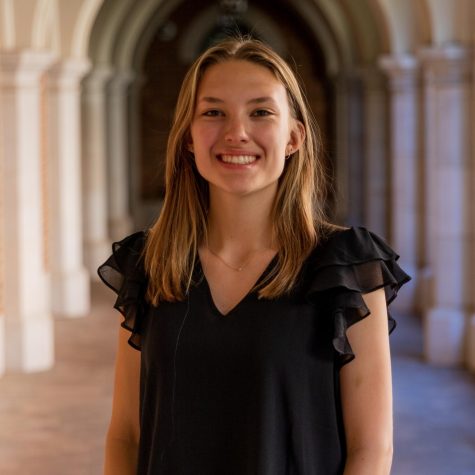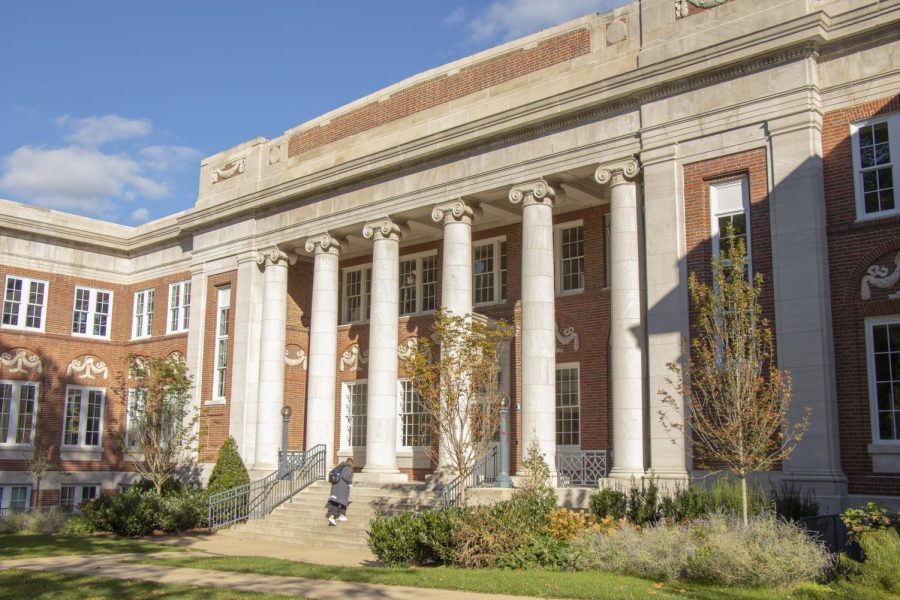I didn’t even know it had happened until hours later.
An event that used to numb people with shock was not even the first thing on my feed when I scrolled through my News app at lunch on Feb. 14. Even now, barely a couple weeks since three students died and five were injured in East Lansing, you would be hard-pressed to find stories about it. Because it’s “old.” Because it’s normal.
As an education student in Peabody College, one of the tasks in our coursework is to think critically about what we want in a classroom environment. As future educators, we study what is important for students to have, to feel and to experience, both at an individual level and as part of a learning community. One component of the classroom environment that always stuck with me was “creating a safe environment.”
Teachers are tasked with creating and maintaining a bubble of safety, where students feel comfortable expressing themselves, interacting with peers and engaging with their school community. As an educator, this means knowing your school’s resources for each student’s needs or, when those resources fall short, providing specialized care and support.
As a teacher caring for your students on a personal level, you witness many young people dealing with way more external burdens than they should ever have to. Given the number of grown-up and seemingly unending challenges that children often have to overcome — whether it be a family tragedy, financial uncertainty, social anxiety, abuse, homelessness, addiction, grief, hunger, depression, illness or any other obstacle — children need a space to breathe. Children need a space to be.
Post-pandemic, young people need a safe space in school more than ever. Our teachers have a real opportunity, and I would argue duty, to create a protective environment in the classroom away from all the chaos that lives outside school walls.
However, for all the theory and practice that one could ever learn about making a safe classroom, there is a present and terrifying danger that threatens even the most nurturing and well-intentioned classroom environments. This threat is pervasive, sudden and life-threatening. In mere moments, it can rip away the protection of a place that was meant to be safe. A place to breathe. A place to be. The threat of gun violence.
This threat introduces the sickening question: Why in the world would somebody attack the young and vulnerable within our schools? Why would somebody want to hurt innocent children as they try to build their future in classes of math, reading or science? How are victims’ families supposed to endure seeing the bus drive to their street corner every day of the week, knowing they won’t get to embrace anyone coming off it? The frightening thing is that we don’t have an answer to any of these questions, despite hundreds of tragedies.
I will always admire those who put themselves in front of deadly weapons to protect others. Teachers don’t belong in that group. Teachers should never have to belong in that group.
We’ve reached a point where when the next generation of teachers asks students to hide under their desks, we will know exactly how they feel. We will be the future generation of teachers that were once students curled up under those same desks, holding our breath and waiting for danger to pass.
As someone who has fallen in love with teaching, I am paralyzed by the thought of facing the day when I’m called to be the protector of our young people against an armed intruder. No teacher ever thinks it could happen to their school, their community, or their home until the day they are asked to face the unthinkable. I desperately hope that day for me never comes — not that there’s any guarantee.
I had the opportunity to teach science to middle schoolers as part of a summer program this past year. These kids came to mean so much to me over two short months – all of them are so full of life and wonder and joy, and are truly such a gift to any teacher that gets the privilege of seeing their smiles every day. They have all had more than their fair share of life challenges from which a school can — and should — provide refuge. They deserve a place to breathe. They deserve a place to be.
My first couple of days before the students arrived were filled with training after training. But only one made me feel so deeply uncomfortable and unwell; the day I learned ALICE training. ALICE (Alert, Lockdown, Inform, Counter and Evacuate) is a program used nationwide to inform schools and organizations of the process to keep people safe in the case of an armed intruder. I sat at a desk with my fellow cohort of teachers and followed step by step what might happen in various situations and how we should respond.
But the most unsettling part of being in that room? Not stacking desks against the door as a barricade like some disfigured ivory tower. Not covering every window to the point of blocking out the rays of sun. Not picking up the staplers and heavy books to have in hand. Not memorizing every exit in the building and how long it would take to walk 20 students there. Not even the helplessness that sat over the room like an ugly fog. Truly, the scariest part of being in that room was how familiar it felt.
We grew up hiding under our desks. We grew up with “code red.” We grew up fearing the stranger outside the door, rattling the handle, checking the lock, all of us huddled together in complete darkness. And what if the intruder wasn’t from outside but within? We all heard stories of students in schools who opened fire at their own peers. What then? Were we ever truly safe?
I swallowed and blinked. I had missed 15 minutes of our instructor’s lesson, trapped within the lockdown of my own memories and fears. We’ve reached a point where when the next generation of teachers asks students to hide under their desks, we will know exactly how they feel. We will be the future generation of teachers that were once students curled up under those same desks, holding our breath and waiting for danger to pass.
People often mention the stark effect that a tragedy can have when it “hits close to home.” Just in the past few weeks, in my hometown of Wake County, North Carolina, a young person brought an AR-15 to a basketball game at Millbrook High School and a loaded gun was confiscated from a student in the hallway of Rolesville High School 11 minutes from my house. All told, there have been more than 20 threats or weapons reported at schools in my area in the past month alone, including one threat that put six different schools from elementary, middle and high all in lockdown on the same day.
I remember getting a phone call one night about these events and, all at once, feeling like the air was being sharply removed from my lungs. I have family that teaches at a school down the street. The threat is now tangible. It feels real. It feels inescapable.
After I hung up the phone, all I wanted to do was fly home to my family and hold on so very tight. But I couldn’t. Devoid of all comfort, I sat on my dorm room floor, curled into a ball and cried until I fell asleep. A very pervasive and paralyzing feeling settled in: no one has any guarantee that they will escape gun violence. Everyone who cares deeply for the young people and teachers who have had their lives so tragically cut short have no chance to breathe. No chance to be.
I refuse to believe we’ll never see the day when school really is the safe space it is meant to be, the space our young people deserve. A refuge. An escape. A home — especially at a university like the very one we attend, where school and home become in many ways the same place.
In these moments of despair, caving into my worst fears, I am flung back into those dark, suffocating childhood classrooms that haunt my nightmares. Just a fragile child clutching a stapler, hiding under the desk and staring at the door handle in the darkness, praying with everything I have in me that no intruder from outside or within is there to hurt people.
I hope for a day where this isn’t our normal. I hope for a day when violence against our children in their classrooms isn’t our reality. I refuse to believe we’ll never see the day when school really is the safe space it is meant to be, the space our young people deserve. A refuge. An escape. A home — especially at a university like the very one we attend, where school and home become in many ways the same place.
This is my desperate request that we as a unified university, community and nation take action to prevent this unnecessary suffering with a passion so deep and driving that real change happens. So that Sandy Hook never happens again. So that Parkland never happens again. So that UVA never happens again. So that Michigan State never happens again. So that this never happens at another school period. The ever-growing list of “never happens again” has become forever endless.
Let me know what I can say or do so that you, legislators, teachers, students, friends, family and country, take notice. Not just take notice — take action. Look into the eyes of hurting, tired, overworked, frightened teachers and students who will step in front of a bullet to save lives. Let them know that you want to do something.
It can be small. It can be anything. But please, please, make it something. Don’t let tragedy be our normal. Don’t stand by while teachers are forced to become a student’s only lifeline. Don’t keep scrolling when lives get cut so heart-wrenchingly short.
If you need a place to start, one resource in which I find some comfort is the Sandy Hook Promise. Founded and led by families who endured the tragedy at Sandy Hook Elementary in 2012, they have created and funded free “Know the Signs” programs to help prevent school shootings before they happen and created paths for bipartisan legislation that will change our country’s school safety laws for good. To be candid, it’s not a permanent solution. But surely, it’s a place to start.
To all of those who have been and continue to be affected by the recent events at Michigan State, my heart hurts so deeply for you. Not only for the tragedy that was forced upon you but for the beautiful, wonderful, irreplaceable pieces of your lives that were taken by gun violence.
We’re living together in a world of so much hurt, and we must do something about it. This heartbreak may never end, but that doesn’t mean we shouldn’t fight it.















